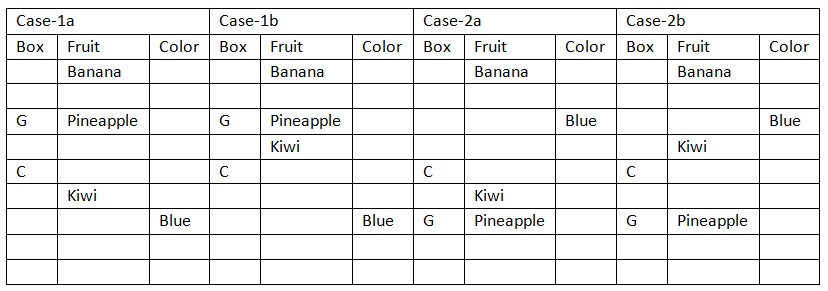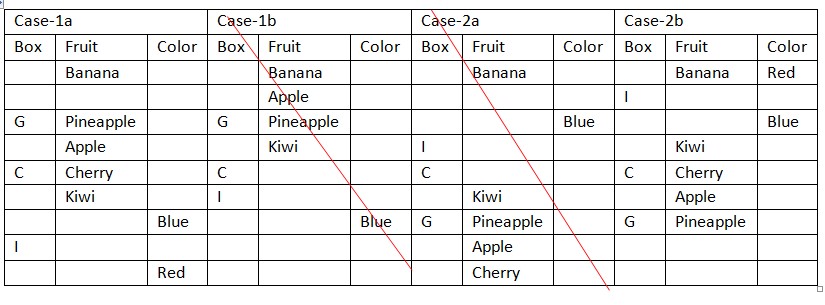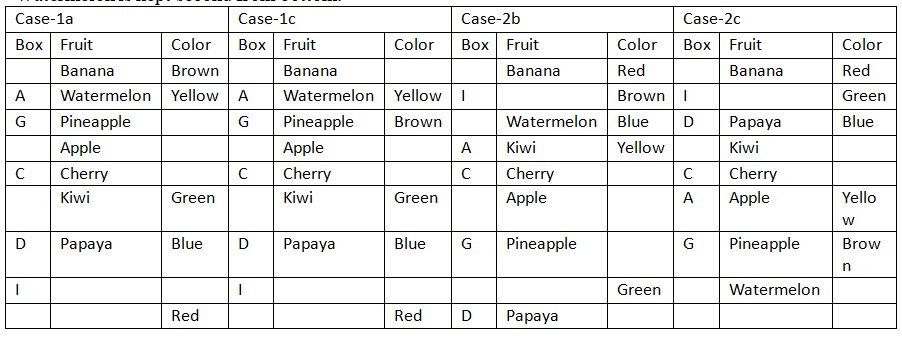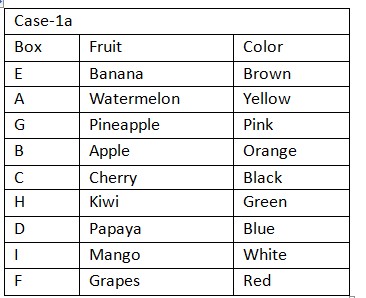Question
How many boxes are kept between one that contains Mango
and one wrapped with Blue paper? Study the following information carefully and answer the questions given below it. Nine boxes namely – A, B, C, D, E, F, G, H and I are kept one above other. Each box contains different fruits viz. Apple, Banana, Grapes, Mango, Kiwi, Papaya, Watermelon, Pineapple and Cherry. Each box is wrapped with different colored paper viz. Black, Blue, Green, Yellow, Brown, White, Red, Pink and Orange. All the given information is not necessary in same order. Box G which contains Pineapple is kept at a gap of three boxes from one which is wrapped with Blue paper. Only one box is kept between box that contains Pineapple and box C. Only three boxes are kept between box C and the one that contains Banana, which is kept at top. Box which contains Watermelon is neither kept adjacent to the one which contains Papaya nor kept at bottom. The box which contains Kiwi and box C, which doesn’t contain Apple are kept adjacent to each other. Box A is wrapped with Yellow paper is kept at a gap of three boxes from the one which is wrapped with Green paper. Box I, which is neither kept adjacent to box G nor with the one that contains Kiwi, but it is kept at a gap of three boxes from the one which contains Apple. Box that contains Apple and Cherry are kept adjacent to each other. Only four boxes are kept between the one which contains Apple and the one which is wrapped with Red paper. Only two boxes are kept between the one that contains Mango and the box which is wrapped with Black paper. The box wrapped with Green paper is kept just above box D which contains Papaya. Box that wrapped with Brown paper is not kept at bottom. Box that contains Grapes kept just below one wrapped with White paper. Box E, which is neither wrapped with Pink nor white paper is kept at any place above box H, which is kept at a gap of one box from box B. Number of boxes between E and H is same as number of boxes between box F and one which wrapped with Orange paper. Box F neither wrapped with Brown paper nor contains Books. Box which wrapped with Pink paper is kept at any place above box wrapped with Orange paper. Box which contains Watermelon and one wrapped with Brown paper is kept adjacent to each other.Solution
Only three boxes are kept between box C and one that contains Banana, which is kept at top. Only one box is kept between box that contains Pineapple and box C. Box G, which contains Pineapple, is kept at a gap of three boxes from one which is wrapped with Blue paper, that means we have two possible place for box G, in case (1) G is kept third from top and in case (2) box G is kept third from bottom. The box which contains Kiwi and box C, which doesn’t contain Apple, are kept together, that means we have four possible places for box that contains Kiwi. Based on above given information we have:  Box I, which is neither kept adjacent to box G nor one that contains Kiwi, is kept at a gap of three boxes from one that contains Apple. Box that contains Apple and Cherry are kept to gather Only four boxes are kept between one that contains Apple and one that is wrapped with Red paper, that means case (1b) and (2a) is not valid.
Box I, which is neither kept adjacent to box G nor one that contains Kiwi, is kept at a gap of three boxes from one that contains Apple. Box that contains Apple and Cherry are kept to gather Only four boxes are kept between one that contains Apple and one that is wrapped with Red paper, that means case (1b) and (2a) is not valid.  Case (1b) is not valid as box that contains Apple and Cherry are kept together and case (2b) is not valid as box that contains Apple and one wrapped with Red paper are kept at a gap of four boxes. Box A is wrapped with Yellow paper is kept at a gap of three box from one wrapped with Green paper. The box wrapped with Green paper is kept just above box D which contains Papaya, that means in case (1a) A is kept second from top, in case (2b) box A is kept fourth from top, in case (2c) box A is kept fourth from bottom. Box which contains Watermelon and one wrapped with Brown paper is kept together. Box that wrapped with brown paper is not kept at bottom. Box which contains Watermelon is neither kept adjacent to one contains Papaya nor kept at bottom, that means in case (1a) box wrapped with Brown is kept at top, in case (1c) box G is wrapped with Brown paper, in case (2b) box I is wrapped with Brown paper, in case (2c) box that contains Watermelon is kept second from bottom.
Case (1b) is not valid as box that contains Apple and Cherry are kept together and case (2b) is not valid as box that contains Apple and one wrapped with Red paper are kept at a gap of four boxes. Box A is wrapped with Yellow paper is kept at a gap of three box from one wrapped with Green paper. The box wrapped with Green paper is kept just above box D which contains Papaya, that means in case (1a) A is kept second from top, in case (2b) box A is kept fourth from top, in case (2c) box A is kept fourth from bottom. Box which contains Watermelon and one wrapped with Brown paper is kept together. Box that wrapped with brown paper is not kept at bottom. Box which contains Watermelon is neither kept adjacent to one contains Papaya nor kept at bottom, that means in case (1a) box wrapped with Brown is kept at top, in case (1c) box G is wrapped with Brown paper, in case (2b) box I is wrapped with Brown paper, in case (2c) box that contains Watermelon is kept second from bottom.  Only two boxes are kept between one that contains Mango and box which is wrapped with Black paper. Box that contains Grapes kept just below one wrapped with White paper. Number of boxes between E and H is same as number of boxes between box F and one which wrapped with Orange paper. Box E, which is neither wrapped with Pink nor white paper, is kept at any place above box H, which is kept at a gap of one box from box B. Box which wrapped with Pink paper is kept at any place above box wrapped with Orange paper. Box F neither wrapped with Brown paper nor contains Kiwi, that means in case (1a) box F is kept at bottom, case (1c), (2b) and (2c) are not valid. Based on above given information we have final arrangement as follow:
Only two boxes are kept between one that contains Mango and box which is wrapped with Black paper. Box that contains Grapes kept just below one wrapped with White paper. Number of boxes between E and H is same as number of boxes between box F and one which wrapped with Orange paper. Box E, which is neither wrapped with Pink nor white paper, is kept at any place above box H, which is kept at a gap of one box from box B. Box which wrapped with Pink paper is kept at any place above box wrapped with Orange paper. Box F neither wrapped with Brown paper nor contains Kiwi, that means in case (1a) box F is kept at bottom, case (1c), (2b) and (2c) are not valid. Based on above given information we have final arrangement as follow:  Case (1c), (2b) & (2c) is not true as number of boxes between E and H is same as number of boxes between box F and one which wrapped with Orange paper is not valid. So final arrangement is- Case-1a
Case (1c), (2b) & (2c) is not true as number of boxes between E and H is same as number of boxes between box F and one which wrapped with Orange paper is not valid. So final arrangement is- Case-1a 
Geography books are always together.
- Eight books out of which 4 are part of a series and the remaining are standalone books are to be arranged on a shelf. Find the number of arrangements in wh...
Form all possible words from ASSESSMENT with the condition that the vowels are always together. How many are there?
- There are 3 identical toys and 4 identical books. How many distinct arrangements are possible on a shelf such that all three toys do not appear together?
In how many different ways can the letters of the word ‘PADDLED’ be arranged?
Find total number of ways in which the word “AGGRESSION” can be arranged.
A team of 7 researchers is to be formed from 6 biologists and 4 chemists. Find the number of ways to form the team if it must include at least 5 biologi...
In a bag there are 4 red balls, 3 green balls, and 5 blue balls. If one ball is drawn at random from the bag, what is the probability of drawing a green...
How many straight lines can be formed from 9 points out of which 4 are colinear?
In how many different ways can 6 boys and 3 girls to be seated in a row such that all the boys seated together and all the girls seated together?
Relevant for Exams:


